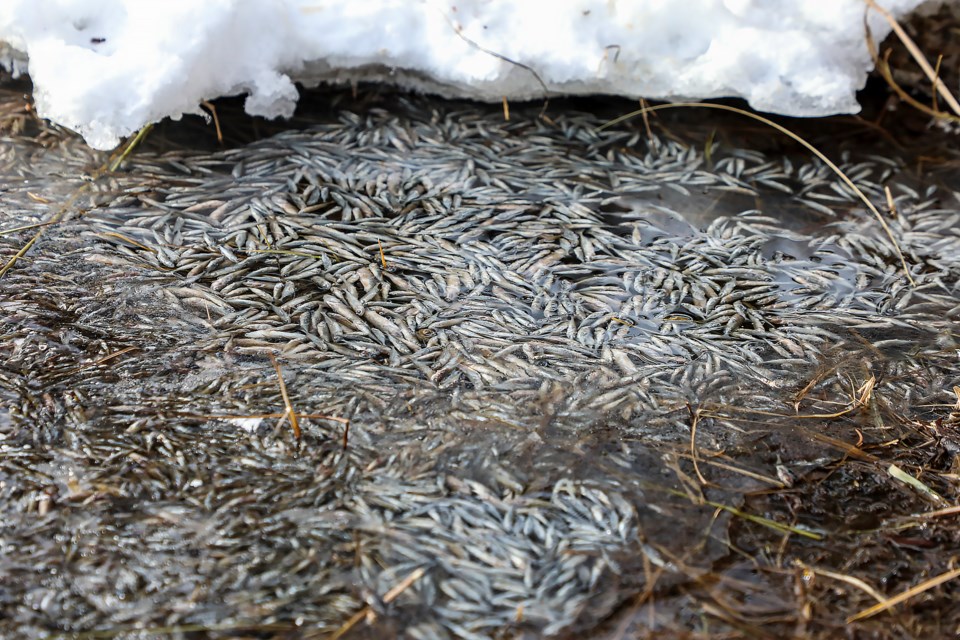BANFF – Thousands of dead and dying fish have been found in Vermilion Lakes near Banff.
Parks Canada got a call from a member of the public Saturday (Jan. 8), and upon investigation and testing, aquatics experts discovered that dissolved oxygen levels of the lake were very low.
They say that very likely resulted in a naturally occurring phenomenon referred to as winterkill, whereby the aquatic life is deprived of oxygen over a sustained period of time leading to their demise.
“We’re talking about thousands, if not potentially tens of thousands, unfortunately… a lot of juveniles,” said Mark Taylor, an ecologist team leader for aquatics in Banff National Park. “They are white suckers and brook stickleback.”
Winterkill, which most commonly affects shallow, nutrient rich lakes and wetlands, occurs when ice and snow levels above the water’s surface become so thick that light cannot penetrate the water column.
As a result, aquatic plants and algae cannot produce oxygen through photosynthesis, resulting in a decrease in the amount of oxygen available to the aquatic life below the ice, which can cause mass fish die-offs.
“We knew that we had a cold spell before Christmas in addition to a snowstorm and so we went out on the ice and tested the oxygen levels at a number of different locations around the second Vermilion Lake,” said Taylor.
“Sure enough, the oxygen levels were really low – lower than the threshold for aquatic life.”
Taylor said fish that can best deal with low levels of oxygen needs at least three milligrams per litre, and species such as salmonoids – like trout – need upwards of six milligrams per litre.
He said the average reading was 0.8 milligrams per litre.
“It was very low,” he said.
White suckers and brook stickleback – which are native to Vermilion Lakes – are the species impacted by the winterkill.
“We know there’s other species that could potentially be inhabiting the lake, like brook trout for example, but we didn’t see any brook trout,” said Taylor.
“It’s possible there’s just not as many of them in recent years or they were better able to escape the area that was impacted. It’s hard to say, but all we’re seeing out there is white suckers and brook stickleback.”
While birds and coyotes have been seen scavenging the dead fish, the park’s wildlife team has deemed the risk of larger carnivores being drawn to feed on the fish as low at this time.
Taylor said bears are still in hibernation and most of the dead fish are underneath the ice, but added the wildlife team will continue to monitor the situation.
“Right now, there’s a lot of floating ones, but they will sink over time, and out in the open water they’ll be at the bottom of the lake and they won’t be a risk there,” he said.
“You can see them along the margins where it has melted, but we'll monitor that.”
Taylor said thick ice and snow cover is a known recipe for mass die-offs, noting past years may have been much windier and blown away snow in that usually wind-scoured area.
But he said it is also possible beaver activity might have changed the water levels a little, making the lake shallower than normal.
“Fish also go through natural population cycles and it’s possible that the abundance of fish was particularly high in recent years and, therefore, just more fish to consume more oxygen,” said Taylor.
“The only thing we can say for sure is there’s definitely low oxygen because we measured it.”
Winterkill is not necessarily uncommon, especially in areas where there are shallower, warmer bodies of water such as in Ontario, Manitoba and Saskatchewan.
However, Taylor said most of the water bodies in Banff National Park are deeper and colder and not as susceptible to winterkill.
That said, he said the park has records of winterkill at the lakes in 1959 and 1964.
“I would suspect it’s probably happened since 1964 but we just don’t have a record of it,” said Taylor.
The dead and dying fish are visible from the shorelines.
Kira Tryon, public relations and communications officer for Banff National Park, said the public is reminded to remain vigilant of wildlife should they be attracted to the area to feed on the fish.
“Parks Canada will continue to monitor the situation over the coming weeks and months and respond accordingly should issues be identified,” she said.




